Published
- 30 min read
Top AI Tools for DevOps Teams: Automate, Scale, and Save Costs

Key Highlights
- Artificial intelligence is revolutionizing software development by automating key tasks for DevOps teams.
- AI-powered automation tools enhance CI/CD pipelines, predict incidents, and optimize resource allocation.
- Leading solutions like Kuberns offer a comprehensive platform to streamline the entire software delivery process.
- Integrating AI improves productivity, reduces costs, and provides scalable solutions for modern infrastructure.
- These tools provide real-time monitoring and anomaly detection, allowing teams to proactively address potential issues.
- Adopting AI helps reduce developer burnout by minimizing manual effort and handling repetitive tasks.
Introduction
The world of software development is in constant motion, and the integration of artificial intelligence is the latest wave of transformation. For DevOps professionals, AI is not just a buzzword; it’s a powerful ally that is reshaping the software delivery landscape. By automating repetitive tasks, providing intelligent insights, and streamlining workflows, AI enables your team to build, test, and deploy applications faster and more reliably than ever before. If you want to see how this shift translates into simpler deployments in practice, check out Kuberns: The Simplest Way to Build, Deploy, and Scale Full-Stack Apps.
Are you ready to explore how these tools can elevate your DevOps strategy?
Top AI Tools for DevOps Teams to Automate, Scale, and Save Costs
The market is filled with powerful AI-driven platforms designed to support modern DevOps teams. These tools offer advanced AI capabilities that help you automate workflows, optimize resource allocation, and improve scalability. By integrating AI code review tools, developers can automatically detect bugs, security flaws, and performance issues before deployment, ensuring cleaner and more reliable code. By handling everything from code analysis to incident management, they empower your team to focus on innovation instead of manual, time-consuming tasks.
So, what are the best AI tools currently available for DevOps teams? Choosing the right solution depends on your specific needs, but the goal remains the same: to enhance efficiency and drive better outcomes. Below, we explore the top tools that are making a significant impact in the industry, starting with the most comprehensive solution for modern DevOps.
1. Kuberns
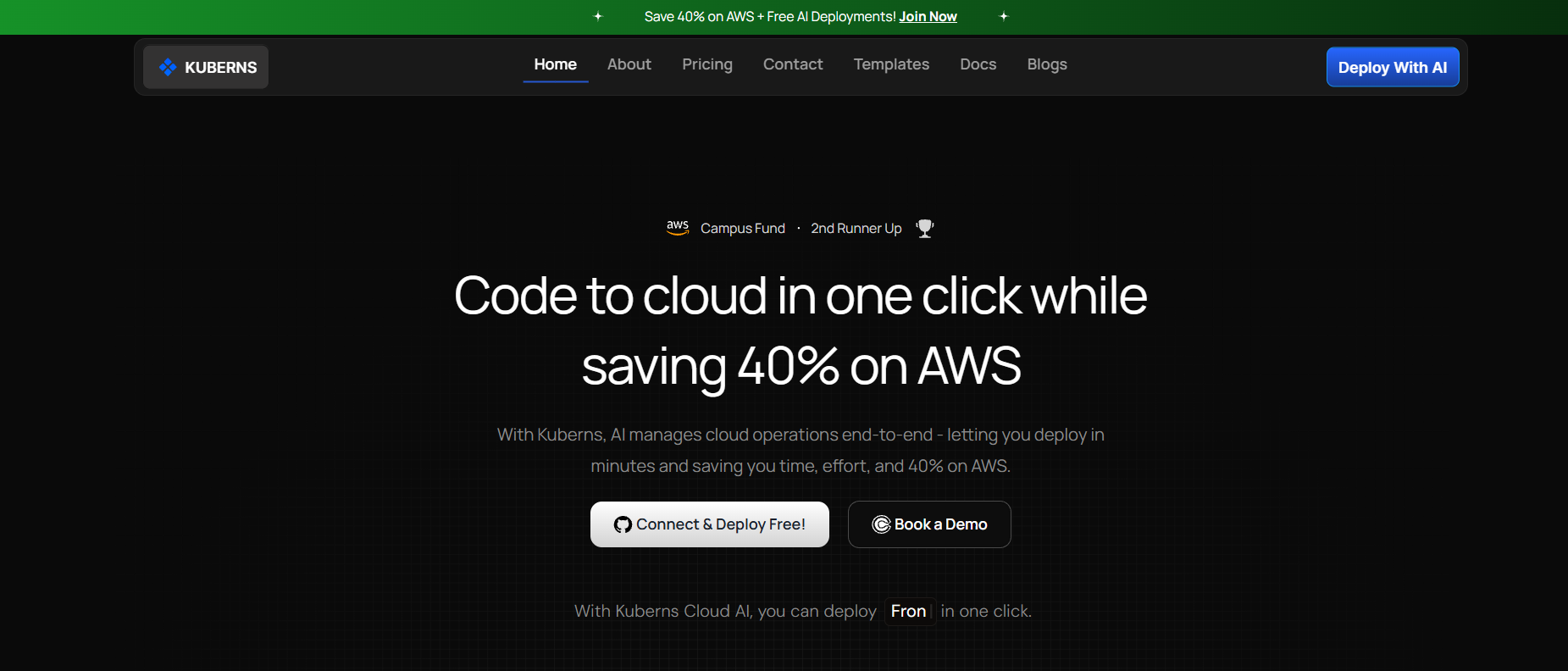 At the forefront of the AI revolution in DevOps is Kuberns, a game-changing AI virtual assistant that acts as a comprehensive solution for your entire team. Unlike specialized tools that solve one part of the puzzle, kuberns leverages Large Language Models across its entire stack. This allows it to automate repetitive tasks, provide actionable insights, and foster seamless collaboration within your DevOps teams. It is the ultimate solution for organizations looking to achieve greater efficiency and innovation without increasing headcount.
At the forefront of the AI revolution in DevOps is Kuberns, a game-changing AI virtual assistant that acts as a comprehensive solution for your entire team. Unlike specialized tools that solve one part of the puzzle, kuberns leverages Large Language Models across its entire stack. This allows it to automate repetitive tasks, provide actionable insights, and foster seamless collaboration within your DevOps teams. It is the ultimate solution for organizations looking to achieve greater efficiency and innovation without increasing headcount.
With Kuberns, you can say goodbye to the complex configuration tools that burden your engineers. It helps you manage your team’s time effectively, empowering them to accomplish more with less effort. By integrating with all your favorite cloud-native tools, Kuberns streamlines critical processes like code deployment, testing, monitoring, and incident management. This allows your team to automate workflows and deploy with greater confidence and speed.
Imagine managing your infrastructure, from container images to CI/CD pipelines, with a single, intelligent platform. That’s the power Kuberns delivers. It provides real-time support and intelligent automation that transforms your DevOps practice from reactive to proactive. To learn more about how to optimize your workflows, check out the latest articles on the kuberns.com/blogs page.
2. GitHub Copilot
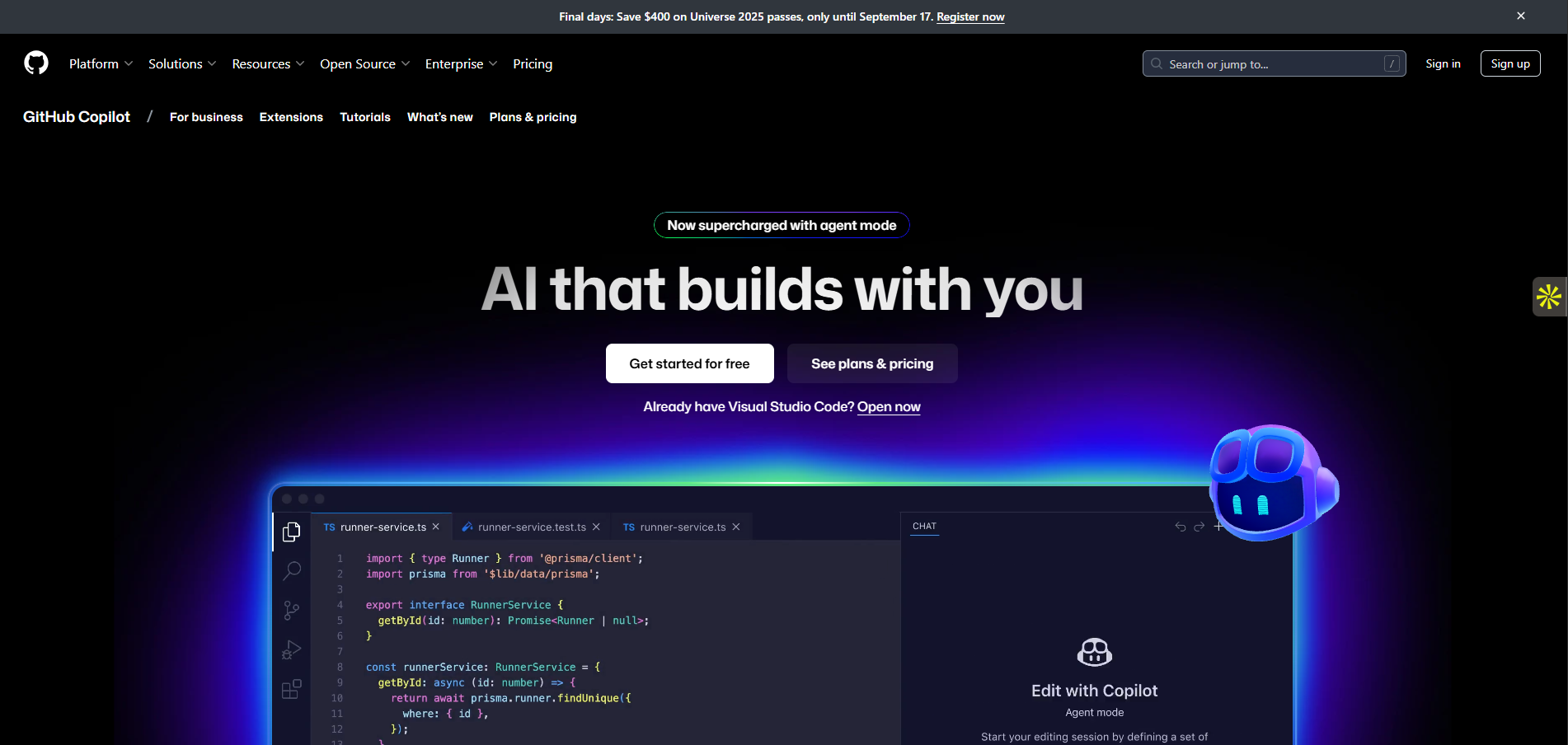 GitHub Copilot is a widely adopted AI coding assistant that helps your developers write code more efficiently. Developed by GitHub and OpenAI, it provides real-time suggestions, from individual code snippets to entire functions, directly within the integrated development environment (IDE). This development tool understands the context of your code and comments, accelerating the development process significantly.
GitHub Copilot is a widely adopted AI coding assistant that helps your developers write code more efficiently. Developed by GitHub and OpenAI, it provides real-time suggestions, from individual code snippets to entire functions, directly within the integrated development environment (IDE). This development tool understands the context of your code and comments, accelerating the development process significantly.
Powered by machine learning models trained on a vast amount of public code, Copilot supports dozens of programming languages. This makes it a versatile tool for DevOps teams working in polyglot environments. By reducing the manual effort of writing boilerplate code, it allows your developers to focus on solving more complex problems and designing better software architecture.
While it boosts productivity, it’s important for your team to review the generated code for security and best practices. GitHub has incorporated filters to reduce risky suggestions, but human oversight remains crucial. Integrating Copilot into your workflow can streamline the initial stages of the software development lifecycle and improve overall speed.
3. AWS CodeGuru
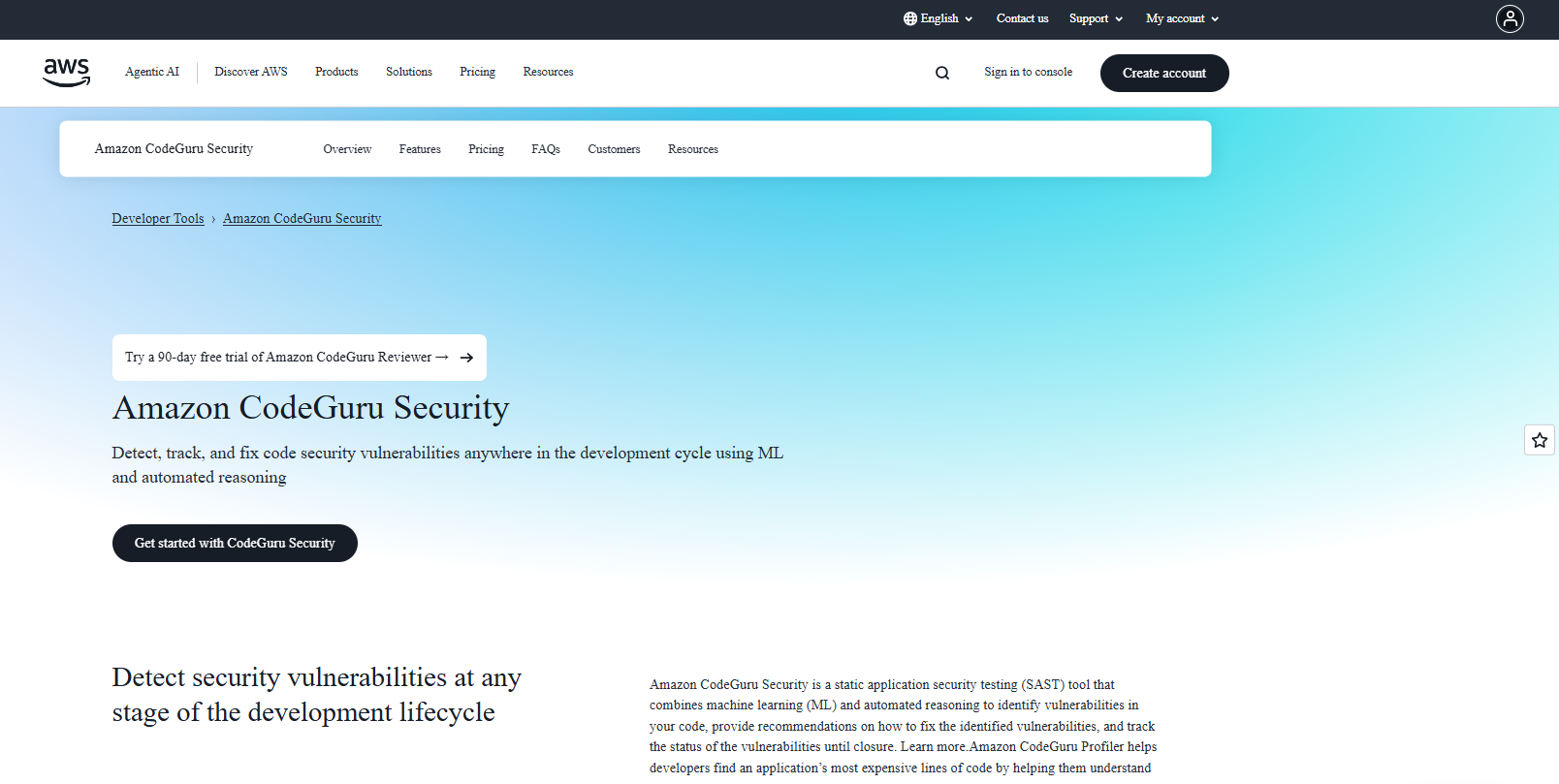 AWS CodeGuru is a developer tool from Amazon that uses machine learning to improve code quality and application performance. It offers two main components: CodeGuru Reviewer and CodeGuru Profiler. The Reviewer automatically analyzes your code during pull requests to find critical issues, bugs, and deviations from best practices, providing intelligent recommendations for fixes.
AWS CodeGuru is a developer tool from Amazon that uses machine learning to improve code quality and application performance. It offers two main components: CodeGuru Reviewer and CodeGuru Profiler. The Reviewer automatically analyzes your code during pull requests to find critical issues, bugs, and deviations from best practices, providing intelligent recommendations for fixes.
The Profiler focuses on application performance, monitoring your live applications to identify inefficient code and suggest optimizations. This helps you reduce CPU utilization, decrease latency, and lower operational costs. By integrating this code analysis tool into your software development lifecycle, you can proactively address potential performance bottlenecks before they impact end-users.
For DevOps teams, AWS CodeGuru offers a way to automate parts of the code review process and gain deeper insights into production environments. Its ability to provide context-aware suggestions helps streamline development and reduce the manual burden of performance tuning and cost reduction efforts.
4. Datadog
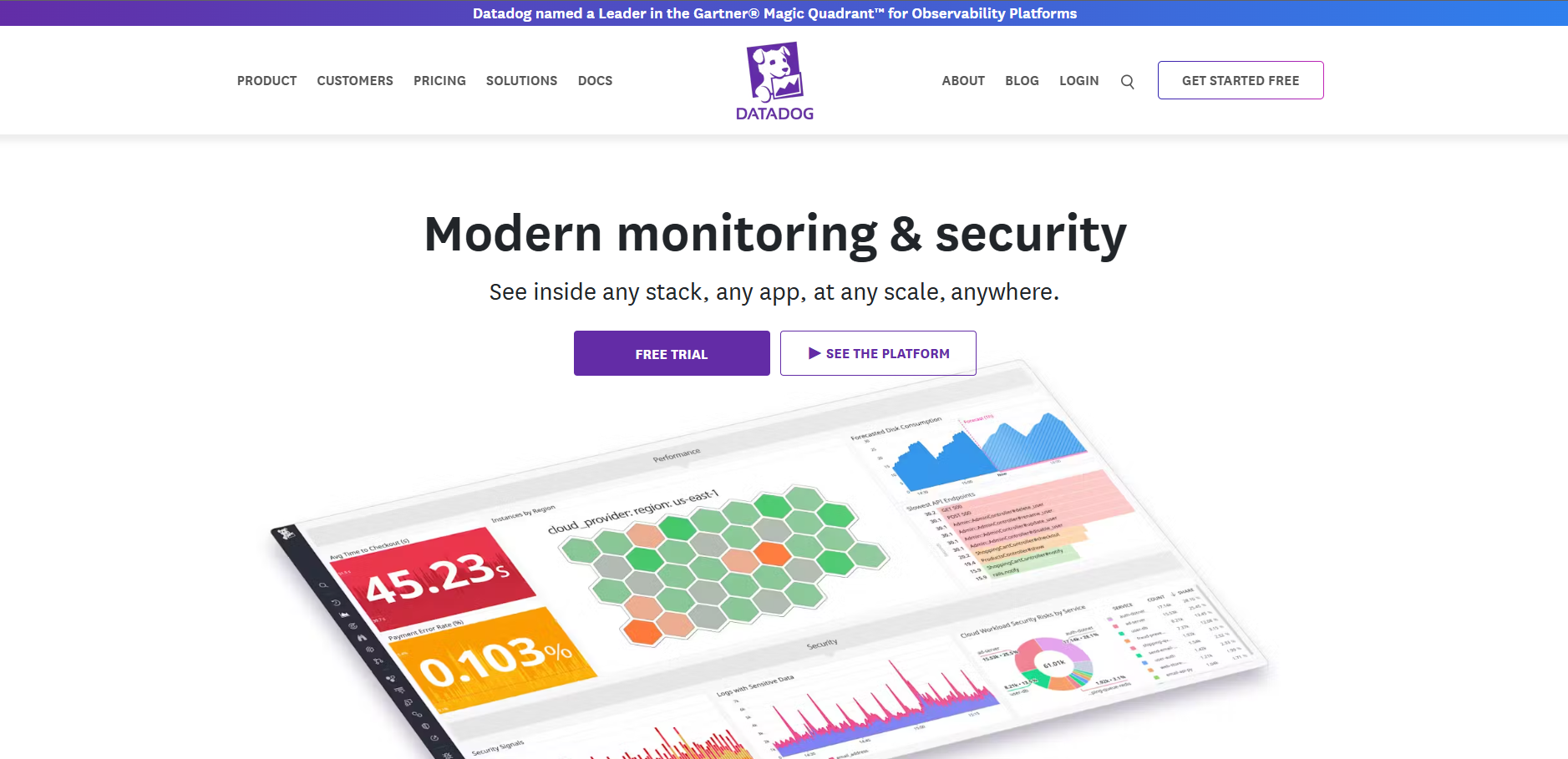 Datadog is a comprehensive observability platform that unifies metrics, traces, and logs in a single place. For Site Reliability Engineers (SREs) and DevOps teams, it provides a holistic view of your entire tech stack, from infrastructure to application performance. Its AI-powered features, like the Watchdog, automatically perform anomaly detection on your telemetry data without requiring manual setup.
Datadog is a comprehensive observability platform that unifies metrics, traces, and logs in a single place. For Site Reliability Engineers (SREs) and DevOps teams, it provides a holistic view of your entire tech stack, from infrastructure to application performance. Its AI-powered features, like the Watchdog, automatically perform anomaly detection on your telemetry data without requiring manual setup.
This real-time monitoring capability allows your team to identify performance issues and outliers before they escalate into major incidents. Datadog’s AI engine helps with root cause analysis by correlating data from various sources, reducing alert noise and shortening the time it takes to resolve problems. This makes it one of the most helpful AI tools for SREs working in DevOps.
With integrations for over 600 technologies, including Kubernetes and serverless platforms, Datadog offers the visibility needed to manage complex, dynamic environments. Its customizable dashboards and automated alerting help your team stay on top of system health and ensure reliability at scale.
5. New Relic
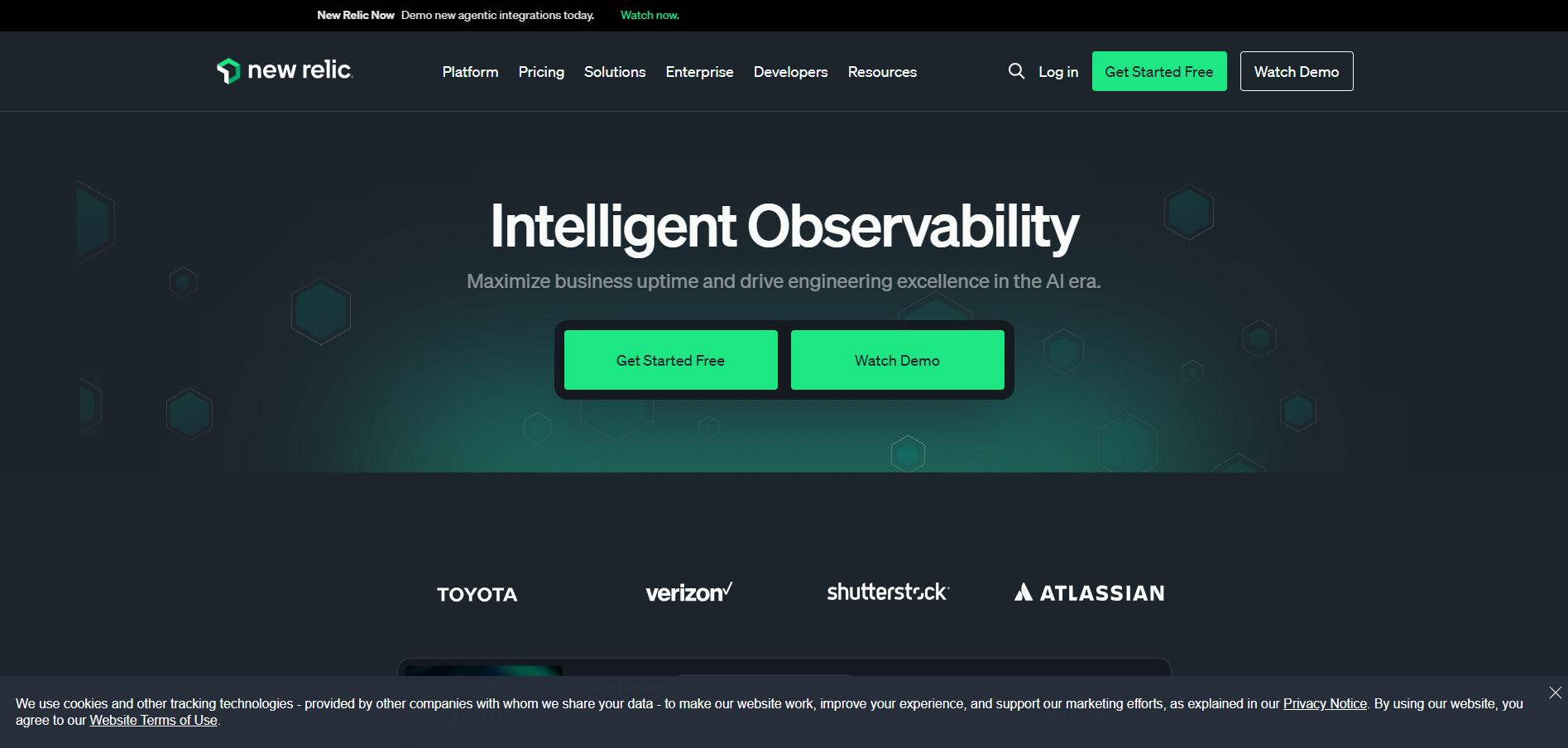 New Relic is another powerful observability platform that provides deep insights into your application performance and user experience. Its AI capabilities, known as New Relic AI, help your DevOps teams make sense of vast amounts of observability data. The platform uses machine learning to automatically detect anomalies, correlate related incidents, and reduce alert fatigue.
New Relic is another powerful observability platform that provides deep insights into your application performance and user experience. Its AI capabilities, known as New Relic AI, help your DevOps teams make sense of vast amounts of observability data. The platform uses machine learning to automatically detect anomalies, correlate related incidents, and reduce alert fatigue.
One of its key features is the ability to provide end-to-end visibility into AI-powered applications, helping you monitor performance and manage costs effectively. For incident management, New Relic helps you quickly identify the root causes of issues by integrating data from multiple sources. This accelerates resolution and minimizes downtime.
New Relic also allows users to interact with their data using everyday language, making complex analysis more accessible to everyone on the team. By integrating with tools like GitHub Copilot, it helps create a more seamless workflow between development and operations, enhancing overall efficiency.
6. Sysdig
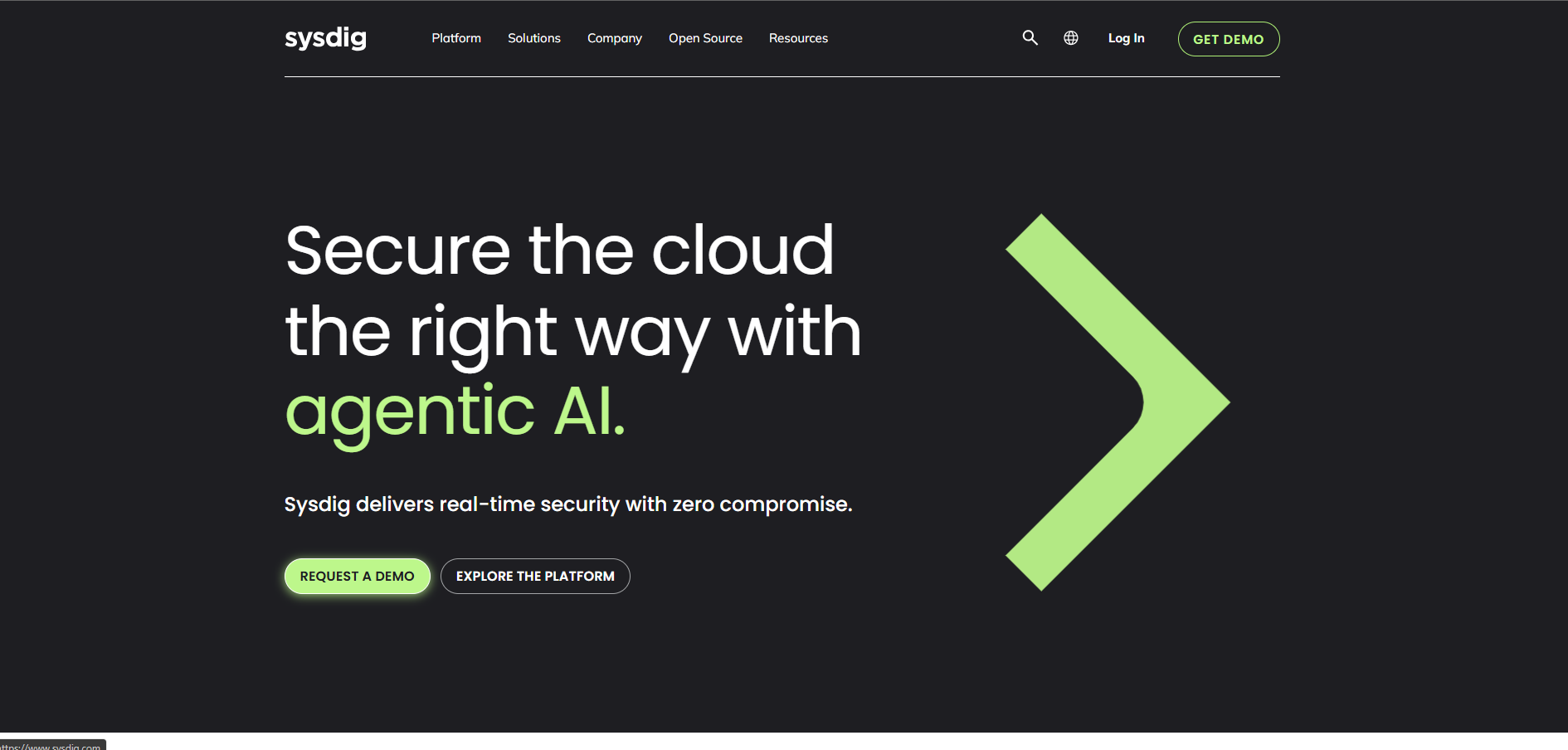 Sysdig offers a unified platform for cloud security and monitoring, tailored for containers, Kubernetes, and microservices. It helps your DevOps teams secure the entire software lifecycle, from build to production. Its AI and machine learning features enhance its observability tools, providing advanced threat detection and compliance management. What role does AI play in modern DevOps platforms like Sysdig? It automates the detection of anomalies and security threats.
Sysdig offers a unified platform for cloud security and monitoring, tailored for containers, Kubernetes, and microservices. It helps your DevOps teams secure the entire software lifecycle, from build to production. Its AI and machine learning features enhance its observability tools, providing advanced threat detection and compliance management. What role does AI play in modern DevOps platforms like Sysdig? It automates the detection of anomalies and security threats.
The platform provides deep visibility into your workloads, including system calls and network activity, which is crucial for troubleshooting and performance tuning. Sysdig’s cloud security posture management (CSPM) capability continuously scans your cloud infrastructure for misconfigurations and policy violations, offering automated remediation suggestions to keep your environment secure.
By integrating security into the CI/CD pipeline, Sysdig ensures that container images and configurations are scanned for vulnerabilities before deployment. This proactive approach to security helps your DevOps teams build and ship applications with confidence, embedding security into every step of the process.
7. Mabl
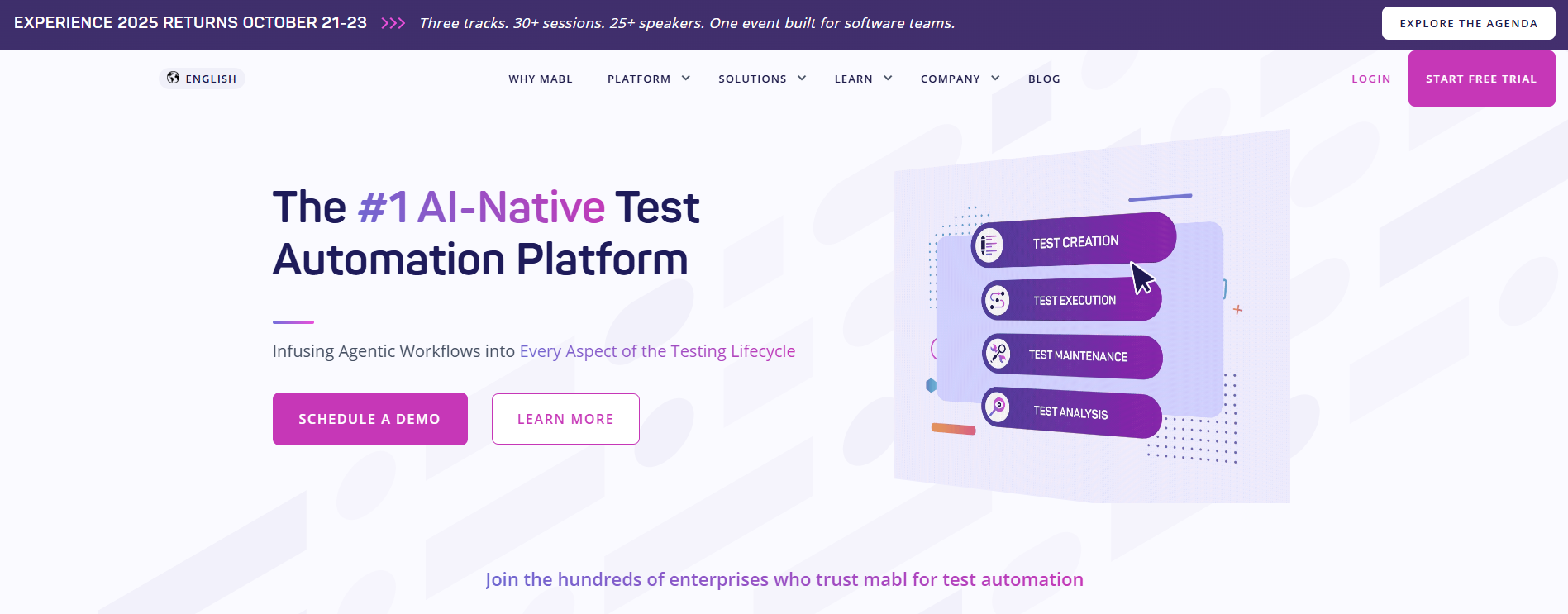 Mabl is an intelligent test automation platform designed to make web application testing faster and more reliable. It uses machine learning techniques to automate the creation, execution, and maintenance of tests. This helps your team increase test coverage without the high maintenance burden often associated with traditional automation tools. How are AI-driven automation tools like Mabl changing the daily tasks of DevOps professionals?
Mabl is an intelligent test automation platform designed to make web application testing faster and more reliable. It uses machine learning techniques to automate the creation, execution, and maintenance of tests. This helps your team increase test coverage without the high maintenance burden often associated with traditional automation tools. How are AI-driven automation tools like Mabl changing the daily tasks of DevOps professionals?
Mabl’s AI automatically adapts tests to changes in your application’s UI, which significantly reduces the time spent fixing broken tests. Its machine learning models also learn your application’s timing to dynamically adjust test execution, leading to more stable and reliable results across different environments. This helps you catch regressions early in the development cycle.
Furthermore, Mabl can detect unexpected visual changes and performance regressions, ensuring both a consistent user experience and high application quality. By simplifying test creation and maintenance, Mabl allows your team to integrate comprehensive testing seamlessly into the CI/CD pipeline, accelerating delivery.
8. Jenkins X
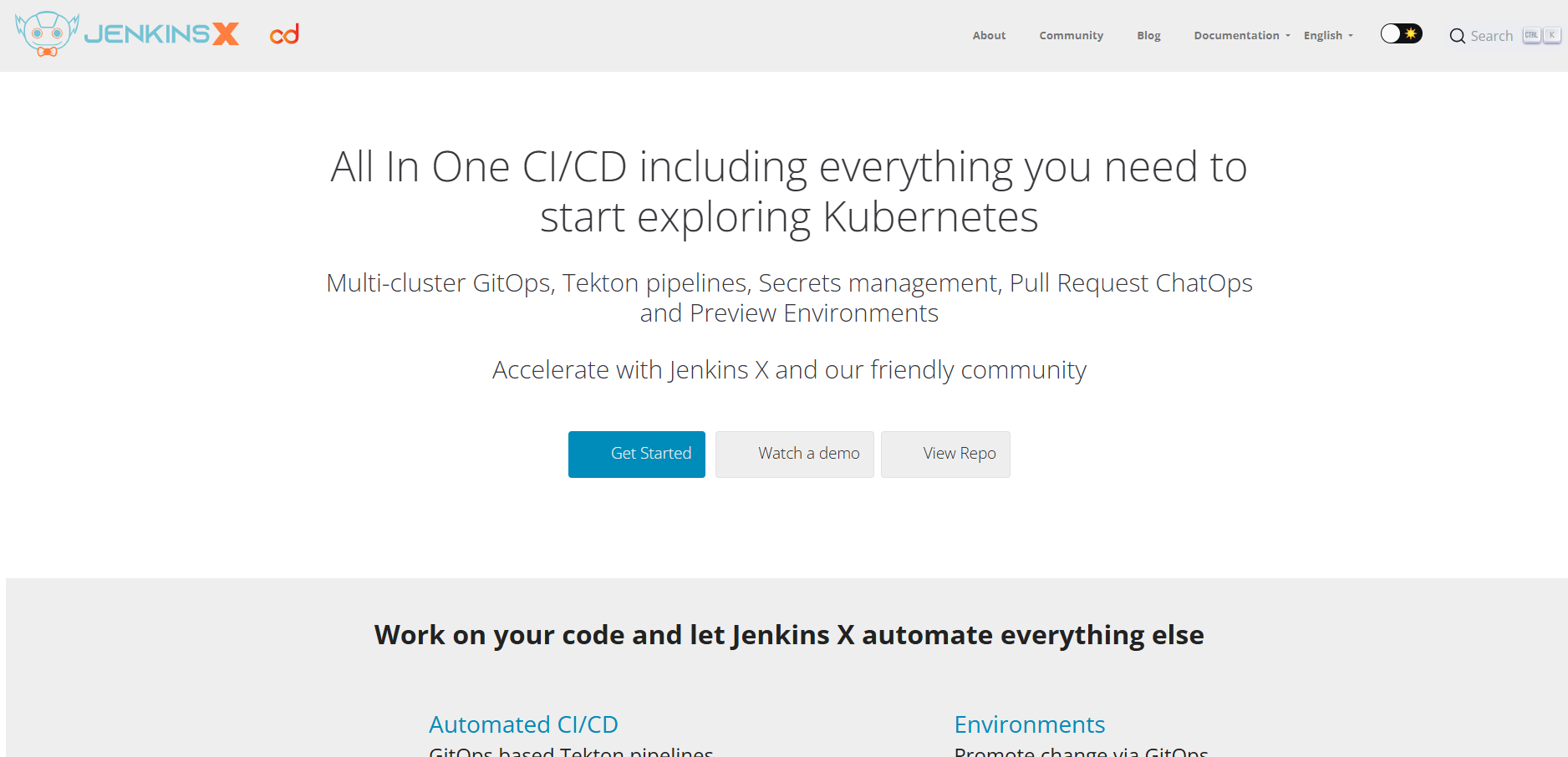 Jenkins X is a cloud-native automation platform that enhances continuous integration and continuous delivery (CI/CD) for modern applications. While based on the popular Jenkins automation server, Jenkins X is specifically designed for Kubernetes and leverages other open-source projects like Tekton to create automated CI pipelines. It simplifies the setup of complex delivery workflows.
Jenkins X is a cloud-native automation platform that enhances continuous integration and continuous delivery (CI/CD) for modern applications. While based on the popular Jenkins automation server, Jenkins X is specifically designed for Kubernetes and leverages other open-source projects like Tekton to create automated CI pipelines. It simplifies the setup of complex delivery workflows.
This platform automates your environment management and promotion through GitOps, ensuring that your cluster’s state is version-controlled and auditable. How do AI-powered platforms improve the efficiency of DevOps workflows? While Jenkins X itself isn’t AI-native, it can be extended with AI plugins that provide predictive analytics for build failures, helping your team address issues proactively.
These AI capabilities can also optimize resource allocation during the build process and even automate rollbacks if a deployment fails, minimizing downtime. By using Jenkins X, your team can accelerate continuous delivery and manage cloud-native applications more efficiently, bringing automation to the forefront of your operations.
9. CircleCI
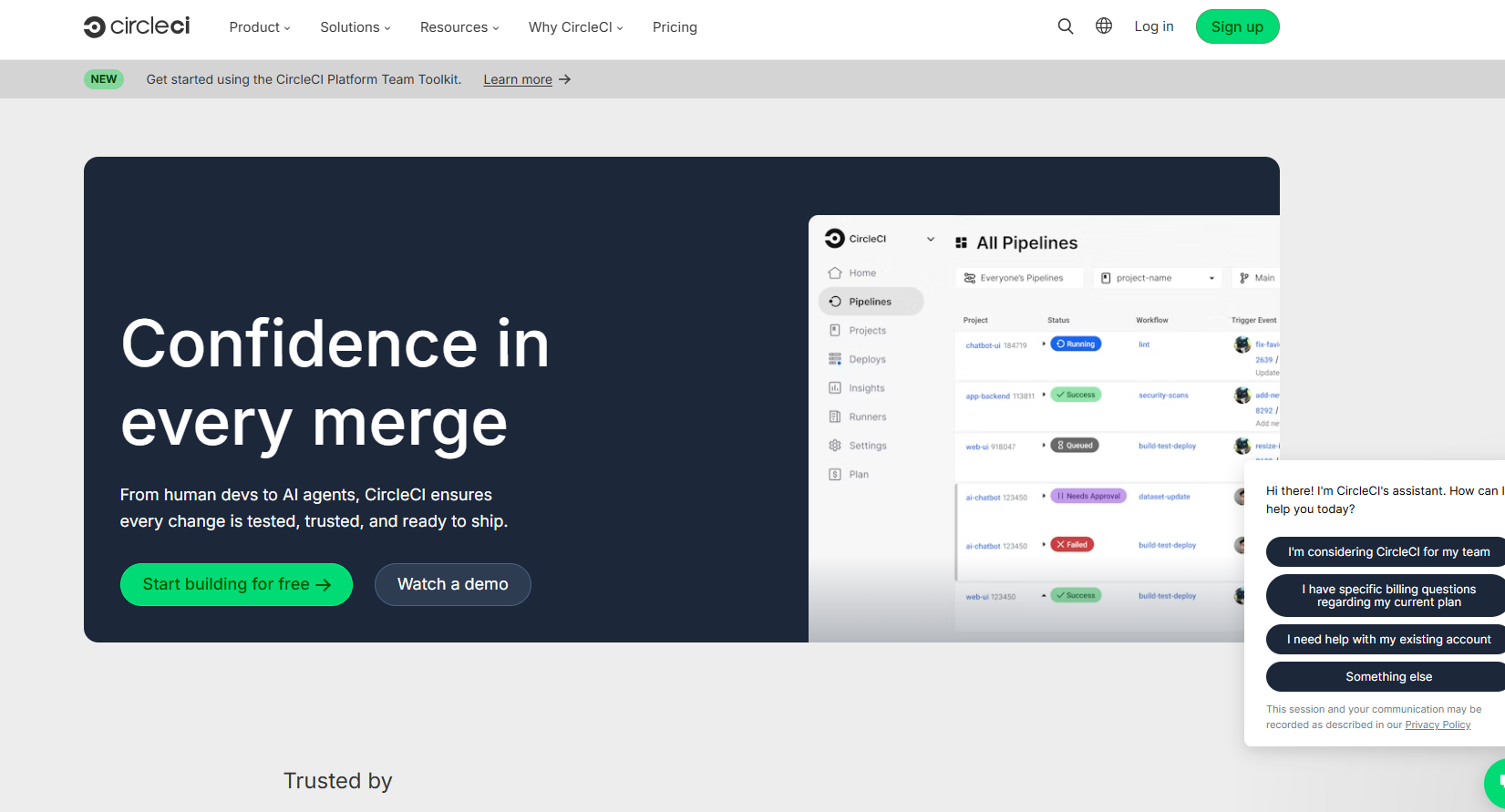 CircleCI is a leading CI/CD platform that automates the build, test, and deployment process for your software projects. It stands out for its speed and flexibility, offering highly configurable pipelines that allow you to define complex workflows. Its AI capabilities are focused on optimizing pipeline execution and resource allocation, ensuring faster feedback loops for your developers.
CircleCI is a leading CI/CD platform that automates the build, test, and deployment process for your software projects. It stands out for its speed and flexibility, offering highly configurable pipelines that allow you to define complex workflows. Its AI capabilities are focused on optimizing pipeline execution and resource allocation, ensuring faster feedback loops for your developers.
The platform enables parallel processing of tasks, which significantly reduces build times and accelerates deployments. CircleCI also offers robust Docker integration, allowing your team to create consistent and reproducible environments across development, testing, and production. This is crucial for maintaining quality and reliability in a fast-paced DevOps culture.
By analyzing historical data, CircleCI’s machine learning algorithms can intelligently schedule jobs and allocate resources, further speeding up your CD pipelines. This focus on efficiency makes it a top choice for teams looking to improve their software delivery speed without compromising on quality or control.
10. Azure DevOps
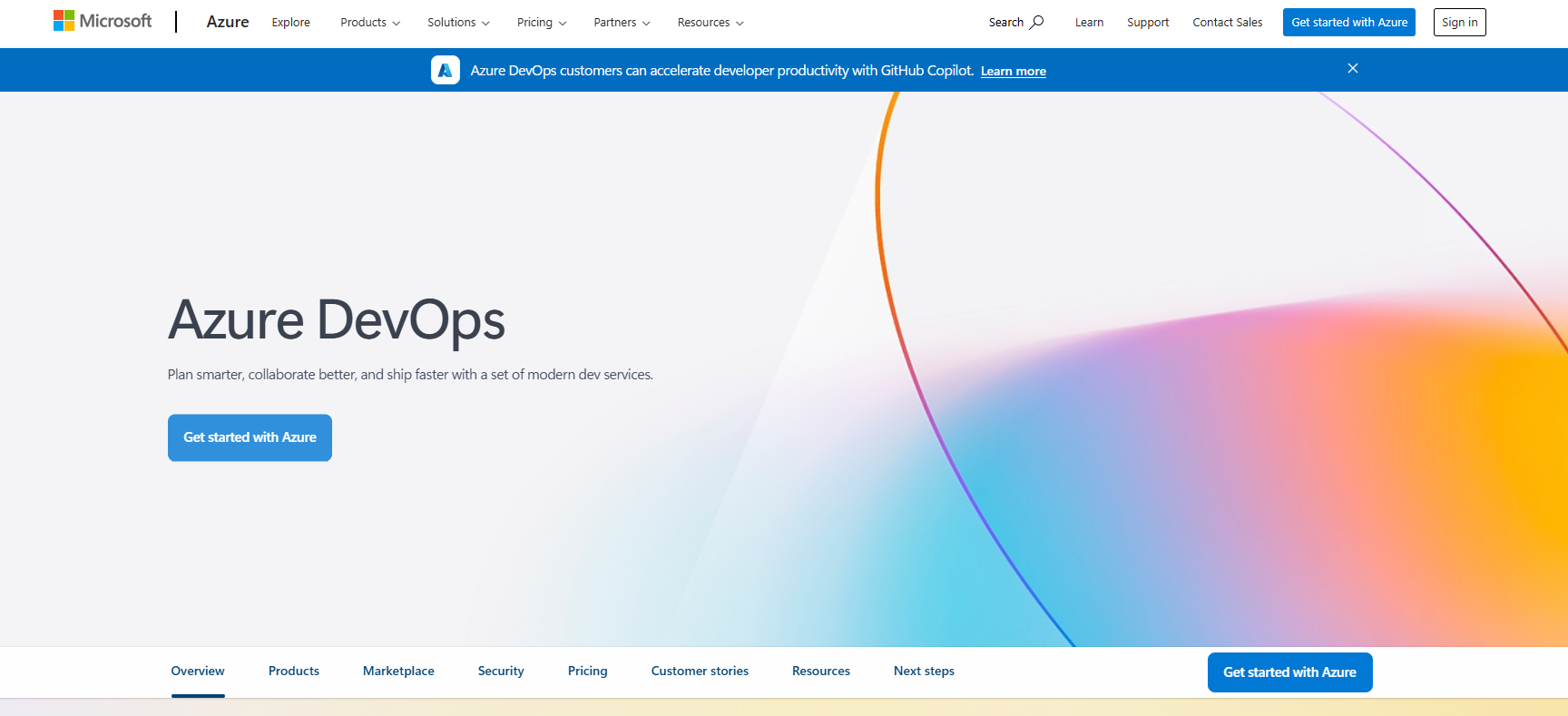 Azure DevOps provides a comprehensive suite of tools from Microsoft that covers the entire development lifecycle. When integrated with Azure’s AI and machine learning services, it becomes one of the most powerful AI automation tools available for DevOps teams. These integrations enhance everything from CI/CD processes to test automation and infrastructure management.
Azure DevOps provides a comprehensive suite of tools from Microsoft that covers the entire development lifecycle. When integrated with Azure’s AI and machine learning services, it becomes one of the most powerful AI automation tools available for DevOps teams. These integrations enhance everything from CI/CD processes to test automation and infrastructure management.
What are the best AI tools currently available for DevOps teams? For teams invested in the Microsoft ecosystem, Azure DevOps is a strong contender. Its AI features can automatically generate test cases based on code changes, improving test coverage and reducing manual effort. It also analyzes build processes to identify bottlenecks and recommends improvements for faster execution.
Furthermore, Azure’s AI can analyze past deployments to predict the success of future ones, helping you reduce the risk of failures. With its focus on resource optimization and scalability, Azure DevOps helps your team deliver software more efficiently while maintaining high standards of quality and reliability.
11. Snyk
 Snyk is a developer-first security platform designed to help you find and fix vulnerabilities early in the development process. It integrates directly into your existing workflows, scanning for security threats in your code, open-source dependencies, container images, and infrastructure-as-code files. What role does AI play in modern DevOps platforms? In Snyk, AI is used to enhance vulnerability detection and prioritization.
Snyk is a developer-first security platform designed to help you find and fix vulnerabilities early in the development process. It integrates directly into your existing workflows, scanning for security threats in your code, open-source dependencies, container images, and infrastructure-as-code files. What role does AI play in modern DevOps platforms? In Snyk, AI is used to enhance vulnerability detection and prioritization.
Snyk’s AI-powered engine improves the accuracy of Static Application Security Testing (SAST), providing real-time feedback as your developers write code. This immediate feedback loop allows for prompt remediation, reducing security risks before they reach production. It also provides actionable fix advice, streamlining the process of securing your applications.
By collecting data from various security and observability tools, Snyk provides a holistic view of your application’s security posture. Its AI-driven continuous monitoring alerts your DevOps teams to new vulnerabilities as they emerge, ensuring your applications remain secure against evolving cloud security threats and improving overall code quality.
12. Splunk
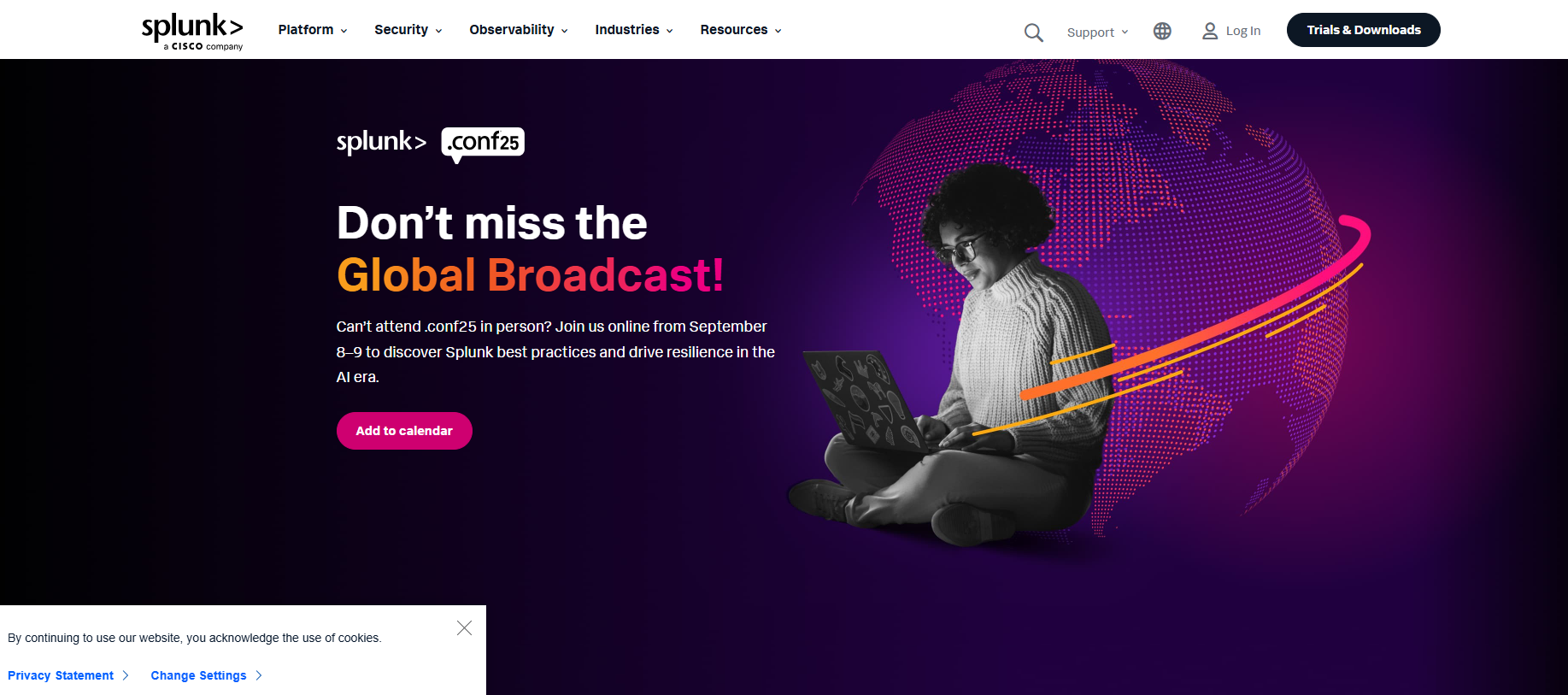 Splunk is a powerful platform for searching, monitoring, and analyzing machine-generated data. For DevOps and Site Reliability Engineers, it turns massive amounts of log data into actionable insights for proactive monitoring and operational intelligence. Its advanced machine learning capabilities make it one of the most helpful observability tools for understanding complex systems.
Splunk is a powerful platform for searching, monitoring, and analyzing machine-generated data. For DevOps and Site Reliability Engineers, it turns massive amounts of log data into actionable insights for proactive monitoring and operational intelligence. Its advanced machine learning capabilities make it one of the most helpful observability tools for understanding complex systems.
Splunk’s AI features offer predictive analytics, anomaly detection, and adaptive thresholding. This allows your team to identify potential issues before they impact users and reduce alert noise by correlating related events. The platform also provides guided workflows that help you create custom machine learning models tailored to your specific use cases, enhancing data analysis.
Recently, Splunk introduced a generative AI chat experience that helps users write and understand its query language (SPL) using plain English. This makes the platform more accessible and empowers your team to extract valuable insights from data more easily, improving both incident response and long-term system reliability.
13. PagerDuty
 PagerDuty is a leading incident management platform that helps your teams detect and respond to production incidents efficiently. Its newest solution, PagerDuty AIOps, integrates artificial intelligence and automation to streamline the entire incident response process. It helps you reduce alert noise, triage issues effectively, and automate repetitive tasks associated with incident resolution.
PagerDuty is a leading incident management platform that helps your teams detect and respond to production incidents efficiently. Its newest solution, PagerDuty AIOps, integrates artificial intelligence and automation to streamline the entire incident response process. It helps you reduce alert noise, triage issues effectively, and automate repetitive tasks associated with incident resolution.
How do AI-powered platforms improve the efficiency of DevOps workflows? PagerDuty AIOps uses machine learning to group related alerts and prioritize critical issues, allowing your team to focus on what matters most. It automatically routes incidents to the right team members based on their expertise and availability, ensuring a rapid response.
This platform works out of the box, requiring minimal implementation and maintenance. By automating scheduling and escalation policies, PagerDuty ensures that incidents are addressed in a structured and timely manner. This helps you minimize downtime and improve the overall reliability of your services.
14. CloudHealth
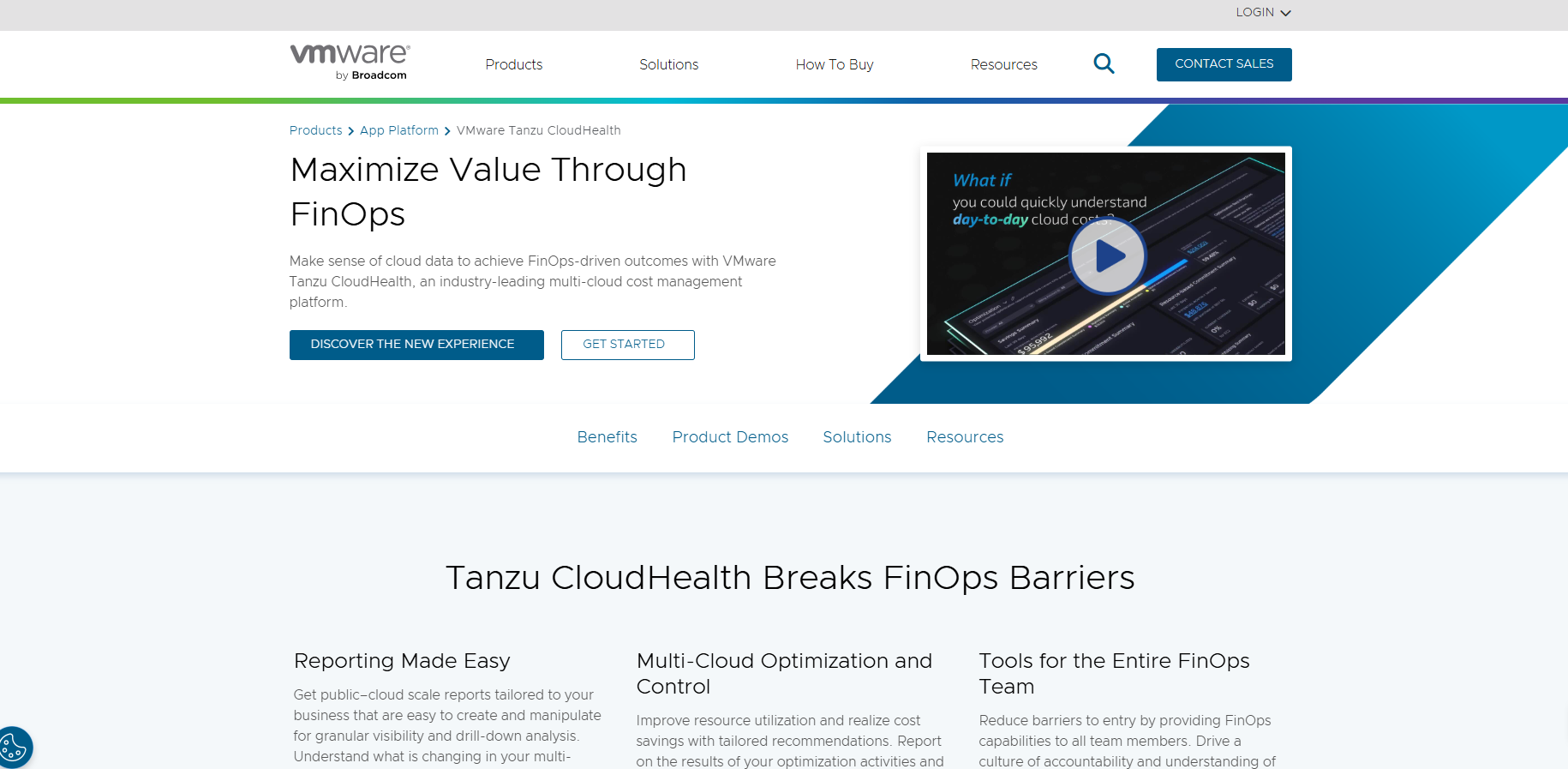 CloudHealth by VMware is a platform that leverages AI to help you optimize your cloud costs and manage resources effectively. It analyzes your cloud usage to provide intelligent recommendations, such as rightsizing instances for your workloads and identifying opportunities for reserved instances. This data analysis can lead to significant cost reduction for your organization.
CloudHealth by VMware is a platform that leverages AI to help you optimize your cloud costs and manage resources effectively. It analyzes your cloud usage to provide intelligent recommendations, such as rightsizing instances for your workloads and identifying opportunities for reserved instances. This data analysis can lead to significant cost reduction for your organization.
What benefits can DevOps engineers expect by integrating AI into their toolchain? With CloudHealth, engineers get actionable insights for optimizing workloads and automating processes. The platform provides detailed cost analysis for Kubernetes clusters, helping you right-size node pools and underlying infrastructure for better performance and efficiency. This is a key advantage in the growing DevOps market.
CloudHealth also improves your cloud compliance and security posture by providing full visibility into misconfigurations. It prioritizes issues based on risk scores and can even automate remediation, helping your team maintain a secure and compliant environment without extensive manual effort in resource allocation. For a deeper look at cutting costs, see AI in DevOps for clous savings.
15. Dynatrace
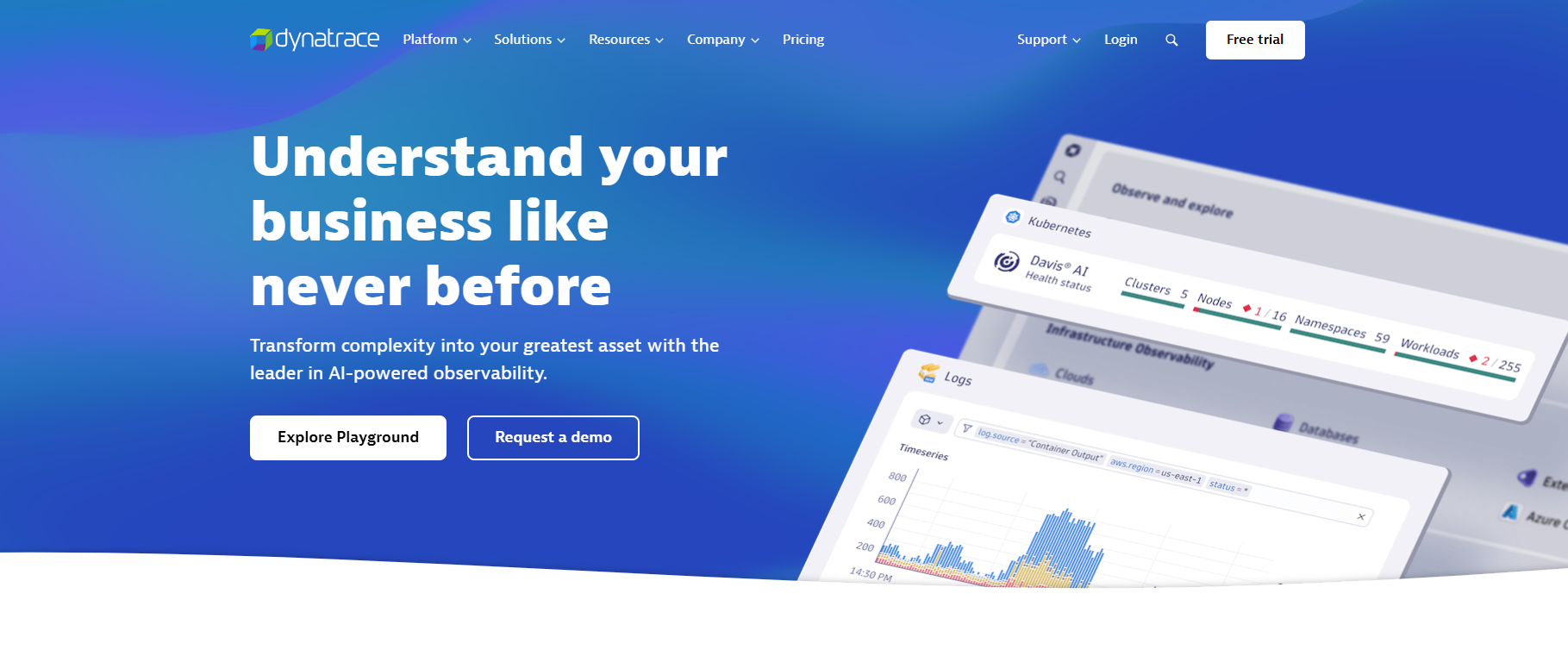 Dynatrace is a full-stack observability platform that uses a powerful AI engine called Davis to provide deep insights into modern cloud environments. Davis AI processes billions of dependencies in real time to perform root cause analysis, detect anomalies, and automate remediation. This helps your team quickly resolve issues and proactively optimize application performance.
Dynatrace is a full-stack observability platform that uses a powerful AI engine called Davis to provide deep insights into modern cloud environments. Davis AI processes billions of dependencies in real time to perform root cause analysis, detect anomalies, and automate remediation. This helps your team quickly resolve issues and proactively optimize application performance.
The platform offers a unified view of your entire tech stack, from infrastructure to end-user experience, by combining metrics, traces, and logs. Dynatrace automatically discovers and instruments your applications and services without requiring manual configuration, making it easy to get started. Its precise performance metrics give you a clear understanding of your system’s health.
For DevOps teams, Dynatrace’s ability to forecast potential issues allows for proactive problem-solving before users are impacted. By autonomously identifying unusual patterns across your environment, it provides actionable insights that reduce troubleshooting time and improve overall system reliability, making it a key player in the 2025 landscape of deployment tools.
16. Ansible
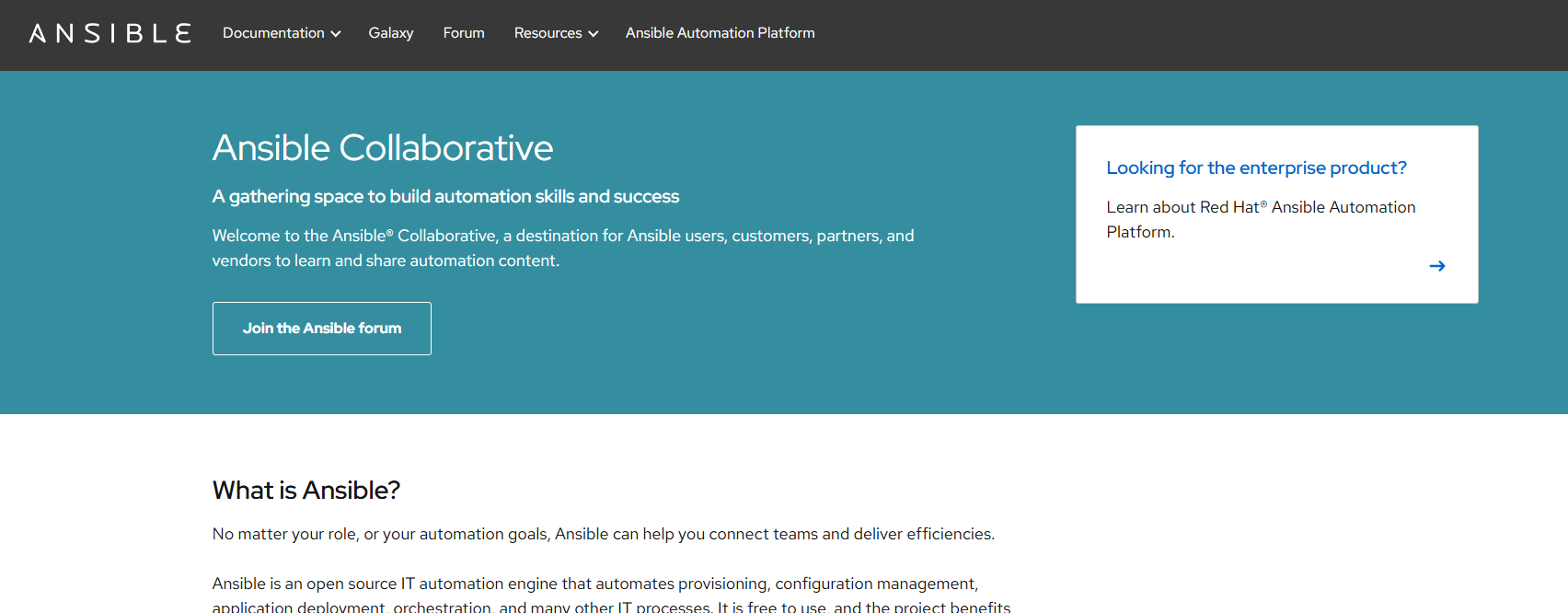 Ansible is a popular open-source tool for IT automation, known for its simple, declarative language for configuration management and application deployment. While not an AI tool by default, integrating Ansible with AI transforms it from a simple automation platform into an intelligent system capable of making real-time decisions and adapting to your infrastructure’s needs.
Ansible is a popular open-source tool for IT automation, known for its simple, declarative language for configuration management and application deployment. While not an AI tool by default, integrating Ansible with AI transforms it from a simple automation platform into an intelligent system capable of making real-time decisions and adapting to your infrastructure’s needs.
When enhanced with AI, Ansible can dynamically adjust configurations based on the current state of your infrastructure. For example, its intelligent algorithms can automate the detection and correction of system issues or use predictive analysis of usage patterns to optimize resource allocation. This brings a new level of intelligence to your automation tools and workflows.
By following best practices and combining Ansible with AI-driven insights, your team can manage complex IT infrastructures more efficiently and at scale. This combination allows you to move beyond simple task automation and create a self-healing, self-optimizing environment that supports your continuous delivery goals.
17. IBM Watson AIOps
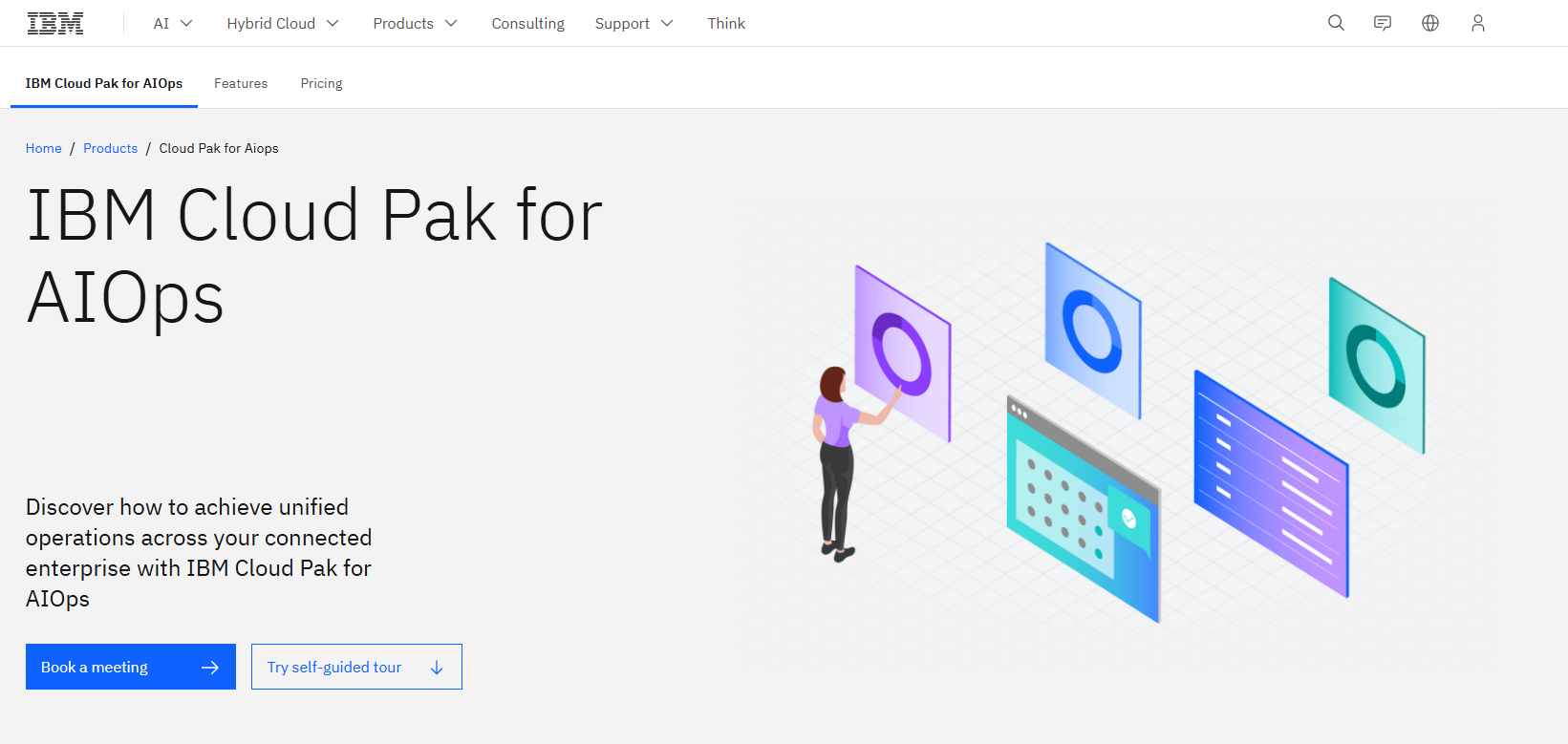 IBM Watson AIOps is a powerful platform that enhances your IT operations using machine learning and natural language processing. It focuses on providing autonomous incident management and resolution by analyzing both real-time and historical data. What role does AI play in modern DevOps platforms like this? It enables proactive issue resolution and minimizes service disruptions.
IBM Watson AIOps is a powerful platform that enhances your IT operations using machine learning and natural language processing. It focuses on providing autonomous incident management and resolution by analyzing both real-time and historical data. What role does AI play in modern DevOps platforms like this? It enables proactive issue resolution and minimizes service disruptions.
The platform offers two core capabilities: predictive analytics and automated troubleshooting. Watson AIOps analyzes data to forecast potential incidents before they occur, allowing your team to address them proactively. It also uses AI-driven analytics to determine root causes by examining log data, alerts, and change history, reducing manual intervention in incident response.
Watson AIOps automatically clusters related events to identify the source of a problem and assesses its impact radius, facilitating quick isolation and resolution. By providing AI-driven recommendations based on historical data, it helps your team resolve outages faster and prevent future incidents, creating a more resilient system.
Key Features of Leading AI DevOps Tools
The AI tools revolutionizing DevOps share several powerful features designed to enhance automation and provide deeper insights. At their core, these platforms leverage machine learning and intelligent automation to streamline complex processes, from development to operations. Platforms like Kuberns bring these AI capabilities together into a single environment, making automation and monitoring easier for small and midsize teams.
Key functionalities include intelligent automation for CI/CD pipelines, predictive analytics for incident management, and real-time monitoring with anomaly detection. Many of these observability tools also prioritize seamless integration with existing DevOps workflows, ensuring you can adopt them without disrupting your current processes. Let’s explore these features in more detail.
Intelligent automation for CI/CD pipelines
Intelligent automation is transforming CI/CD pipelines by making them faster, more efficient, and more reliable. AI-powered automation tools go beyond simple scripting by using machine learning to optimize every stage of your continuous integration and continuous delivery process. For example, Kuberns automate testing, deployment, and rollback in one click, removing the friction of managing multiple services.
How do AI-powered platforms improve DevOps workflows in practice? They introduce a level of intelligence that traditional automation lacks. For instance, AI can analyze code changes to determine which tests are most relevant, reducing execution time while maintaining high test coverage. It can also predict which builds are likely to fail, allowing your engineers to intervene proactively.
This level of automation empowers your team to deliver higher-quality software at a faster pace. Key examples of intelligent automation in CI pipelines include:
- Predictive build failure analysis: Forecasts potential failures based on historical data.
- Smart test selection: Prioritizes tests based on code changes to reduce execution time.
- Automated resource optimization: Dynamically allocates build resources to improve efficiency.
- Automated rollbacks: Reverts failed deployments automatically to minimize downtime.
Predictive analytics for incident management
Predictive analytics is a game-changer for incident management, shifting your team’s approach from reactive to proactive. Instead of waiting for an alert to signal a problem, AI models analyze historical and real-time data to forecast potential issues before they impact your users. Kuberns builds this into its workflow by combining deployment automation with built-in monitoring and automated software deployment, helping teams stay proactive instead of reactive.
How is AI-driven automation changing the daily tasks of DevOps professionals? It allows them to focus on preventing incidents rather than just responding to them. AI algorithms can identify subtle patterns and correlations that a human might miss, providing early warnings about performance degradation or impending system failures. This leads to faster root cause analysis and more effective resolutions.
By providing actionable insights, predictive analytics helps you minimize downtime and improve your overall incident response strategy. Core benefits of this approach include:
- Proactive issue detection: Identifies potential problems before they escalate.
- Faster root cause analysis: Correlates events to pinpoint the source of an issue quickly.
- Reduced alert noise: Groups related alerts to help teams focus on what matters.
- Improved resource planning: Forecasts future needs based on performance trends.
Real-time monitoring and anomaly detection
Real-time monitoring and anomaly detection are fundamental features of modern AIOps platforms. These tools continuously collect and analyze observability data from your entire technology stack, including metrics, logs, and traces. This provides a live, comprehensive view of your system’s health and performance. What role does AI play in modern DevOps platforms? It automates the process of sifting through this data to find meaningful patterns.
AI-powered anomaly detection uses machine learning to establish a baseline of normal system behavior. When the system deviates from this baseline, the AI flags it as a potential issue, often long before it triggers traditional, threshold-based alerts. This allows your team to investigate and find the root causes of problems much faster.
This proactive approach helps you maintain system stability and deliver a better user experience. Key aspects of real-time monitoring and anomaly detection include:
- Automated baselining: Learns normal behavior to detect true anomalies.
- Correlation of observability data: Connects metrics, logs, and traces to provide context.
- Noise reduction: Filters out irrelevant alerts so teams can focus on critical issues.
- Early warning signals: Alerts you to subtle deviations that could lead to major problems.
Seamless integration with existing DevOps workflows
One of the key advantages of Kuberns is that it integrates directly with GitHub, so teams can adopt it without retraining or changing their workflow drastically. Leading AI DevOps tools are designed for seamless integration with the platforms you already use, such as CI/CD servers, version control systems, and monitoring solutions. This ensures a smooth adoption process and maximizes the value of your existing toolchain.
Are AI-driven tools suitable for small and midsize DevOps teams? Yes, especially when they integrate easily. A tool that works well with your current setup lowers the barrier to entry and reduces the need for extensive retraining. This allows your team to start benefiting from its automation tools and AI capabilities almost immediately, regardless of your organization’s size.
The goal is to enhance, not replace, your development cycle. A well-integrated AI tool feels like a natural extension of your workflow. Key benefits of seamless integration include:
- Reduced implementation time: Connects easily with your existing toolchain.
- Unified data and visibility: Consolidates information from multiple sources.
- Improved collaboration: Allows different teams to work together within familiar environments.
- Maximized ROI: Enhances the value of your current technology investments.
Benefits of Integrating AI into DevOps Toolchains
Integrating artificial intelligence into your DevOps toolchain offers a wide range of benefits that can transform your software development lifecycle. By leveraging machine learning, you can dramatically increase productivity, achieve significant cost reduction, and improve the overall reliability of your applications. These advantages empower your team to innovate faster and deliver more value to your customers.
From enhancing the developer experience to providing scalable solutions for your infrastructure, AI is becoming an essential component of modern DevOps. Let’s examine some of the key benefits you can expect when you incorporate these powerful tools into your daily operations.
Enhanced productivity and efficiency for DevOps teams
One of the most immediate benefits of integrating AI into your DevOps workflows is the significant boost in productivity and efficiency. AI-powered automation tools take over repetitive, time-consuming tasks, freeing up your DevOps teams to concentrate on more strategic, high-value work. This shift allows them to focus on innovation, architecture, and complex problem-solving.
How do AI-powered platforms improve DevOps workflows in practice? They streamline the entire development process, from coding to deployment. For example, AI coding assistants can generate boilerplate code in seconds, while automated testing platforms can run and analyze thousands of tests without human intervention. This acceleration of daily tasks leads to faster development cycles.
Ultimately, this means your team can deliver features and fixes to users more quickly and with higher quality. Key ways AI enhances productivity include:
- Automation of repetitive tasks: Reduces manual effort in areas like testing and deployment.
- Faster feedback loops: Provides developers with quicker insights into code quality and performance.
- Streamlined development process: Accelerates workflows from code creation to production.
- Improved focus on innovation: Allows engineers to work on more creative and impactful projects.
Cost reduction through smart resource allocation
What benefits can DevOps engineers expect by integrating AI into their toolchain? A major one is significant cost reduction through intelligent resource allocation. AI-powered tools analyze your infrastructure usage patterns and provide data-driven recommendations to optimize your cloud spend. This helps you eliminate waste and ensure you are only paying for the resources you truly need.
These platforms can identify over-provisioned instances and suggest rightsizing them for your actual workloads. They can also forecast future resource needs, allowing for better capacity planning and more effective use of reserved instances or savings plans. This is where Kuberns AI stands out, offering up to 40% AWS cost savings while handling deployments automatically.
By automating these processes, AI ensures that your infrastructure is always running as efficiently as possible. Specific ways AI helps with cost reduction include:
- Rightsizing recommendations: Suggests optimal instance sizes based on usage data.
- Waste identification: Pinpoints idle or underutilized resources that can be terminated.
- Predictive scaling: Automatically adjusts resources to match demand, avoiding over-provisioning.
- Cost visibility and analysis: Provides detailed breakdowns of where your cloud budget is going.
Improved developer experience and reduced burnout
A positive developer experience is crucial for retaining talent and fostering innovation. AI tools play a key role in this by reducing the friction and toil that often lead to burnout. By automating manual effort and handling tedious tasks, AI allows your engineers to focus on the creative and challenging aspects of their jobs that they find most rewarding.
How does using AI in DevOps help prevent burnout for engineers? It removes the burden of repetitive work, such as manually reviewing logs, triaging low-level alerts, or fixing flaky tests. When engineers can rely on AI to handle these tasks, they have more time and mental energy to dedicate to building great software and improving the user experience.
As Sherif Mansour, Head of Product at Atlassian, notes, “AI is not here to replace developers, but to augment them. It’s about freeing them from toil so they can focus on creativity and problem-solving.” Key improvements to the developer experience include:
- Reduced manual effort: Automates mundane tasks like debugging and testing.
- Faster problem resolution: Provides quick insights to help solve complex issues.
- Less context switching: Integrates into existing workflows, keeping developers in their flow state.
- Focus on high-impact work: Allows engineers to contribute in more meaningful ways.
Scalable solutions for growing infrastructure needs
As your organization grows, so do your infrastructure needs. AI-driven tools provide scalable solutions that can adapt to increasing complexity without requiring a proportional increase in your team’s size. These platforms are designed to manage dynamic, large-scale environments, making them essential for modern cloud-native applications.
Are AI-driven tools suitable for small and midsize DevOps teams? Absolutely. Many of these tools offer flexible pricing models and can scale with you as you grow. For a small team, AI can act as a force multiplier, automating tasks that would otherwise require additional headcount. This allows smaller organizations to compete with larger ones by operating more efficiently.
These solutions also enhance cloud security and reliability at scale, automatically detecting misconfigurations and threats across a growing number of services. Key benefits of scalable AI solutions include:
- Automated management of complex environments: Handles dynamic infrastructure with ease.
- Efficient scaling for DevOps teams: Allows teams to manage more with less manual effort.
- Force multiplier for smaller teams: Enables small organizations to achieve more.
- Enhanced security at scale: Continuously monitors a growing infrastructure for threats.
Challenges and Considerations When Adopting AI in DevOps
While the benefits of AI in DevOps are clear, adopting these tools comes with its own set of challenges. It’s important to approach this transition with a strategic mindset, considering potential hurdles such as security threats, compliance requirements, and the cultural shift needed for successful team adoption. Are there any challenges when adopting AI tools for DevOps workflows? Yes, and planning for them is key.
Successfully integrating AI requires more than just choosing the right platform; it also involves upskilling your team and ensuring that new processes are both secure and effective. By addressing these considerations proactively, you can navigate the path to AI adoption smoothly and unlock its full potential for your organization.
Addressing security and compliance concerns
When you adopt AI tools, especially those that have access to your code and infrastructure, addressing security and compliance concerns is paramount. You need to ensure that these platforms handle your data securely and comply with relevant regulations like GDPR or SOC 2. This involves carefully vetting vendors and understanding their security practices.
Are there any challenges when adopting AI tools for DevOps workflows? A major one is ensuring that the AI itself does not introduce new security threats. For example, AI-generated code must be scrutinized for vulnerabilities just like human-written code. Integrating AI with your observability tools can help you monitor for unusual behavior and potential security breaches.
Following security best practices is essential for mitigating these risks. By taking a proactive approach to security and compliance, you can adopt AI with confidence. Key considerations include:
- Data privacy and security: Ensure sensitive data is encrypted and handled properly.
- Compliance with regulations: Verify that tools meet industry and legal standards.
- Vulnerability scanning: Regularly scan AI-generated code and configurations for threats.
- Access control: Implement strong access controls to limit what AI tools can see and do.
Ensuring team adoption and upskilling
Technology is only as good as the people who use it. For AI to be effective in your DevOps practice, you must ensure successful team adoption. This involves more than just providing new tools; it requires a cultural shift, clear communication, and a commitment to upskilling your team so they feel comfortable and confident using AI.
How do AI-powered platforms improve DevOps workflows in practice? They work best when teams understand how to leverage them Because tools like Kuberns uses a simple GitHub-based workflow, adoption is easier compared to traditional complex DevOps platforms.. Some tools lower the barrier to entry by using plain English for queries, making them more accessible to everyone. Providing training and creating a supportive environment where engineers can experiment and learn is crucial for a smooth transition.
The goal is to empower your team, not overwhelm them. A phased rollout and a focus on practical benefits can help build momentum and enthusiasm during the development cycle. Strategies for ensuring team adoption include:
- Providing comprehensive training: Offer workshops and documentation to get your team up to speed.
- Starting with a pilot project: Test the tool with a small group to demonstrate its value.
- Fostering a culture of learning: Encourage experimentation and knowledge sharing.
- Choosing intuitive tools: Select platforms with a user-friendly interface and clear instructions.
Conclusion
In conclusion, Integrating AI tools into your DevOps practice can dramatically improve productivity, reliability, and speed of delivery. Among these solutions, Kuberns stands out as a practical choice for teams that want to automate deployments, cut cloud costs, and scale without adding unnecessary complexity. Its seamless integration with GitHub, built-in monitoring, and AI-powered automation make it a platform that adapts to both small teams and growing enterprises.
If you’re ready to simplify your workflows and take the manual effort out of DevOps, explore how Kuberns can fit into your toolchain. Get started with Kuberns today and see how it can transform the way your team builds, deploys, and scales applications.

Frequently Asked Questions
What should DevOps engineers look for when choosing an AI tool?
DevOps engineers should look for a development tool with robust AI capabilities that seamlessly integrates with their existing toolchain. Prioritize platforms that offer scalability, provide clear and actionable insights, and support continuous improvement for your DevOps teams.
How do AI-powered platforms improve DevOps workflows in practice?
AI-powered automation tools improve workflows by handling repetitive tasks, optimizing resource allocation, and providing intelligent insights during software development. They reduce manual effort, accelerate feedback loops, and enable teams to proactively identify and resolve issues before they impact users.
Are AI-driven tools suitable for small and midsize DevOps teams?
Yes, AI-driven tools are highly suitable for small and midsize DevOps teams. Many offer scalable pricing and act as a force multiplier, enabling smaller teams to achieve significant cost reduction and efficiency gains, improving their user experience and competitiveness.